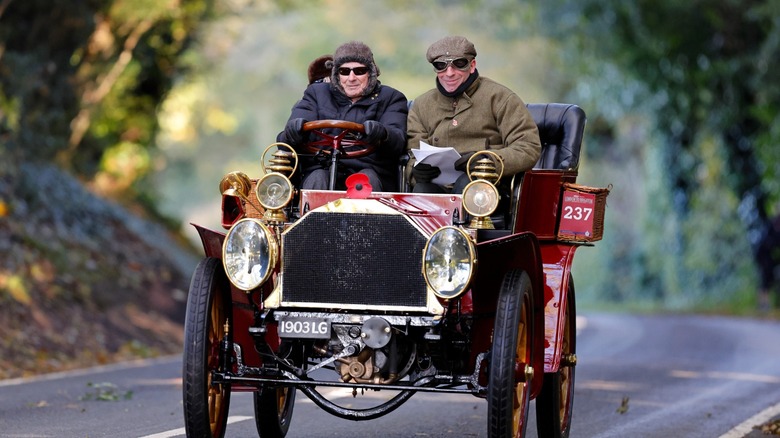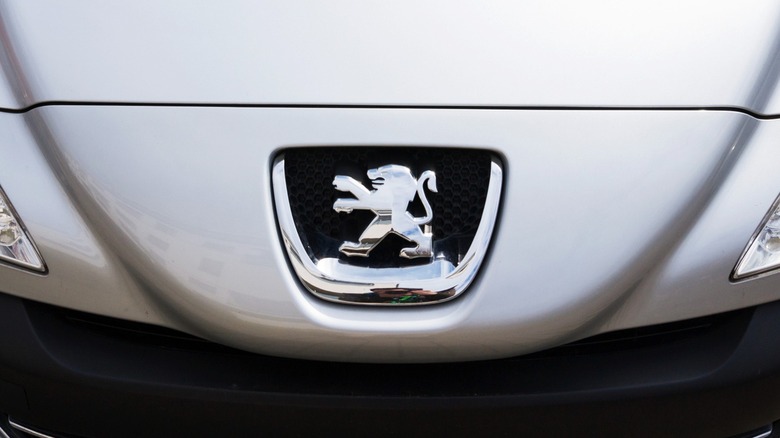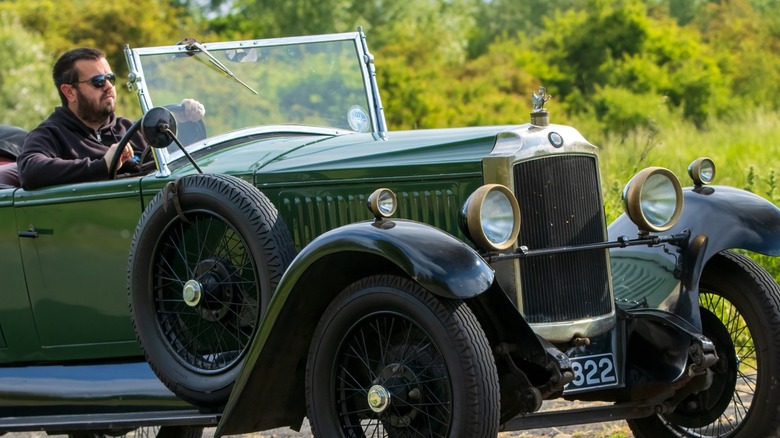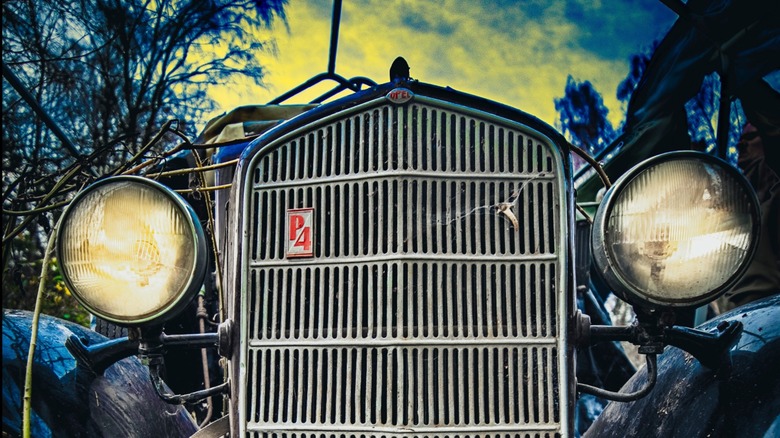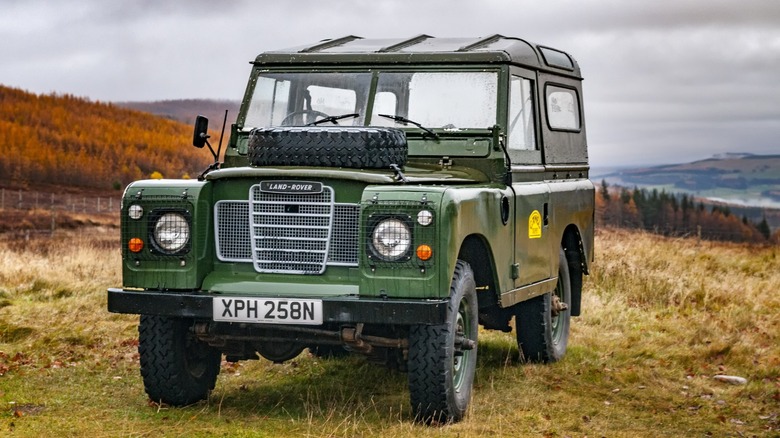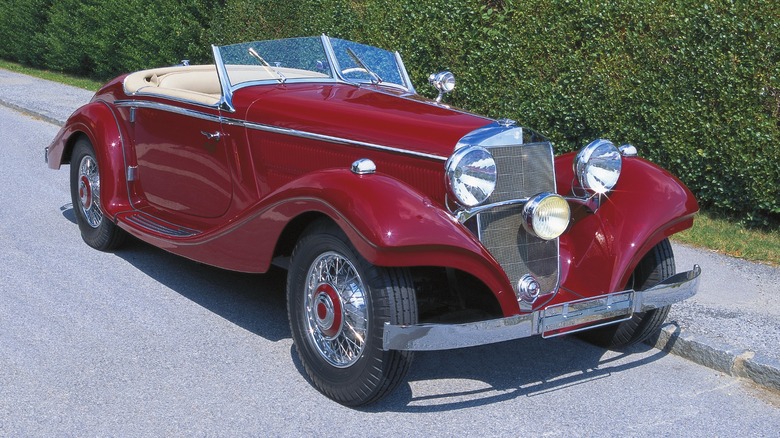These Are The 5 Oldest Car Brands In The World
Cars have been around for more than a century. You probably learned that Ford was the first manufacturer to build cars for the masses in 1908 with its mass-produced Ford Model T. But Ford wasn't the first company to build one. In fact, Carl Benz, of Mercedes-Benz fame, invented the first car in 1886.
However, several other large companies that still make cars today existed before Carl Benz was even born. Although most of them didn't build cars when they were founded, they were typically enterprises that already required engines for other purposes, like milling, making clothes, or producing pedal-powered transportation (i.e., bicycles). As a result, these companies could easily transition to building cars using the parts they already had on hand when the automobile was invented.
Let's look at the five oldest car brands that still produce consumer cars today: Peugeot, Vauxhall, Opel, Land Rover, and, of course, Mercedes-Benz.
Peugeot (1810)
Today, Peugeot is one of the biggest French brands, alongside Renault and Citroën. However, Peugeot did not start as a car maker. Instead, it began as a steel mill, founded in 1810 by the Peugeot brothers Jean-Frédéric and Jean-Pierre II.
The Peugeot family focused on producing artisanal, agricultural, and industrial tools using the steel cold-rolling technique throughout the early 19th century. By 1888, the third generation of Peugeots had moved on to heavier industries, building bicycles and developing motorized vehicles. The following year, Armand Peugeot, the grandson of Jean-Pierre II, showed the first Peugeot automobile at the Paris World Fair. This invention was a three-wheeled carriage powered by a steam-driven engine and designed by engineer Léon Serpollet.
In 1890, Armand created Peugeot's first four-wheeled vehicle powered by a Daimler engine. By 1895, Peugeot had started making vans that could carry 1,100 pounds, solidifying itself as a household name in France and the rest of Europe.
Peugeot bought Citroën in 1975 and created the holding company Peugeot Société Anonyme (PSA) Group to manage both brands. As Peugeot's parent company bought more vehicle brands, its name changed to PSA Peugeot Citroën in 1991 and then the PSA Groupe in 2016. In 2019, Fiat Chrysler of America (FCA) merged with the Peugeot Group, creating Stellantis. This move brought the Peugeot name under a multinational umbrella. The brand was originally expected to enter the U.S. market, but those plans were canceled when the automaker announced it would instead focus on marketing the Alfa Romeo brand presence here instead.
Vauxhall (1857)
Tatra is the second oldest manufacturer today, founded in 1850. However, it has since stopped making cars and is now focusing on trucks. Because of this, we're giving Vauxhall second place as the oldest car manufacturer.
Vauxhall started as Alexander Wilson and Co. in 1857. Alexander Wilson was a Scottish engineer who made steam-powered marine engines near Vauxhall Gardens and Vauxhall Bridge in London, thus earning the moniker Vauxhall Works. By 1894, the company started experimenting with internal combustion engines and was soon reorganized into the Vauxhall Iron Works Company Ltd.
These experiments resulted in a single-cylinder gasoline engine used for river pleasure boats in 1897. Although unconfirmed, some say this engine was used as the basis for the motor that powered Vauxhall's first production car, launched in 1903. After nearly eight years of making practical daily drivers, Vauxhall created the Prince Henry, widely considered to be the first British sports car. However, despite its success in making expensive, high-end cars, demand for them dropped in the early 1920s, hitting Vauxhall hard. So, in 1925, its board sold the Vauxhall brand to GM for over $2.5 million (over $44 million today).
Vauxhall expanded its portfolio to include trucks and vans, which helped keep it afloat through the tumultuous 1960s when many popular British auto brands such as Triumph had to stop building cars. However, GM's European division ran into huge losses in the 2000s. By 2017, General Motors sold the Vauxhall brand for a loss to Groupe PSA. With the 2019 FCA-Groupe PSA merger, Vauxhall is now the stablemate of another American brand: Chrysler.
Opel (1862)
Adam Opel established his namesake company in Rüsselsheim, Germany, just 30 miles southwest of Frankfurt. Founded in 1862 to make sewing machines, Opel branched into bicycle manufacturing in 1886 after securing a piece of the German market.
In 1899, Opel's son, Wilhelm, bought Friedrich Lutzmann's Motorwagenfabrik (motor car factory) and started building cars under the Opel name. By 1907, Opel was making sewing machines and cars alongside each other in its factory. However, a fire burned down the factory in 1911, causing the company to stop operations. When it resumed production, Opel decided to stop making sewing machines and focused all its efforts on automobiles.
By 1928, Opel was the largest German automaker, with 37.5% of the local market share, according to Detroit Free Press. However, the Great Depression in 1929 hit Opel hard, and General Motors ended up acquiring 80% of the company for under $26 million (about $472 million today). By 1931, GM bought Opel's remaining 20% of its shares, making it a fully-owned GM subsidiary.
However, despite being a great success for GM in the 1990s, GM Europe, which had Opel under its belt, was losing about $1 billion annually in the 2010s. So, after nearly 90 years under its care, GM sold Opel (and Vauxhall) to Groupe PSA in 2017. With the latter's merger with FCA, Opel is now under the Stellantis umbrella, putting it alongside other iconic brands such as Alfa Romeo, Jeep, and Maserati.
Land Rover (1877)
Like the other manufacturers in this list, Rover didn't start as a car manufacturer. It was created in 1877 as Starley & Sutton Co. and produced bicycles. In 1883, Starley & Sutton Co. rebranded its products as Rover tricycles and, in 1885, introduced the Rover Safety Bicycle, which is essentially the bicycle design we know today.
In the late 1890s, the company changed its name to Rover Cycle Company Ltd; by 1902, it was making the Rover Imperial motorcycle. A couple of years later, Rover made its first four-wheel car and soon manufactured different models for the general market. However, it wasn't until the 1930s that the brand started to gain popularity as a go-to source for cars in the U.K.
The steady decline of the British car market in the 1960s affected several brands, including Rover. Leyland bought Rover in 1966, and then, in 1968, the former merged with the British Motor Company to establish British Leyland. Rover changed hands once again when British Leyland sold it to British Aerospace in 1988, after which the conglomerate started privatizing its subsidiaries. BMW then bought the brand in 1994, spun off Land Rover as an independent brand in 2000, and sold it to Ford.
The Phoenix Consortium bought the remnants of Rover and MG from BMW in the same year. Unfortunately, this venture came to a close in 2005, spelling the end of the Rover nameplate. Thankfully, the Rover legacy continued with Land Rover under Ford's ownership. In 2008, Ford sold Jaguar and Land Rover to Tata Motors, which continues to sell both nameplates today.
Mercedes-Benz (1883)
Mercedes-Benz is one of the most popular luxury marques in the world and one of the oldest. The Mercedes-Benz name launched in 1926 when some of the oldest automotive companies of the day merged: Daimler-Motoren-Gesellschaft and Benz & Co. Rheinische Gasmotoren-Fabrik. The former was founded by Gottlieb Daimler, who was also the maker of one of the first high-speed internal combustion engines, while the latter was founded by Carl Benz and was at the time the second-largest engine maker in Germany.
The merger resulted from the effects of Germany's loss in the Great War when many companies had to join forces with other corporations in order to avoid bankruptcy and closure. The two companies entered a joint venture in 1924 before officially becoming one entity in 1926 as Daimler-Benz AG.
Chrysler Corporation merged with Daimler-Benz in 1998, thus giving rise to DaimlerChrysler AG. However, this partnership did not last long, as Daimler sold Chrysler in 2007 after a $1.5 billion loss the year before. As a result, the company dropped the Chrysler in its name and became Daimler AG.
At the end of 2021, Daimler AG spun off its truck and bus division as an independent company called Daimler Truck. Once again, Daimler changed its name to Mercedes-Benz Group AG. "The renaming to Mercedes-Benz Group AG underlines our renewed strategic focus," Ola Kallenius, Mercedes' CEO, said in a statement to Motor Authority. "In doing so, we want to make clear where we see the core of our company — building the most desirable cars in the world."
